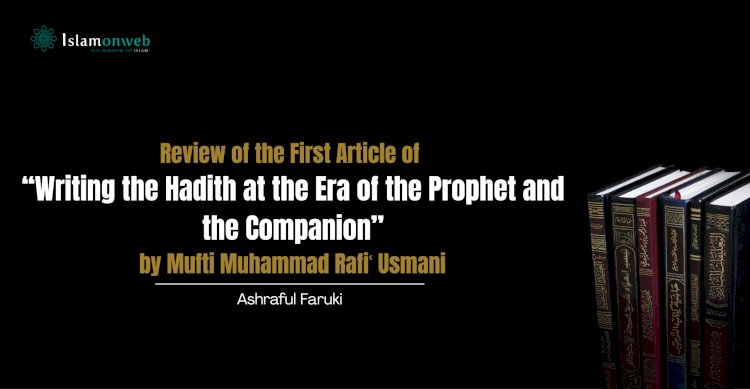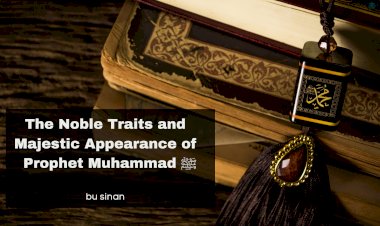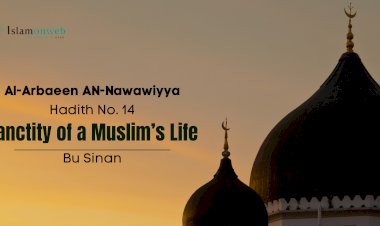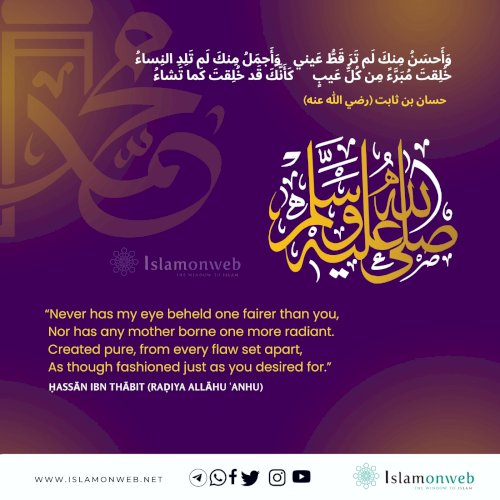Review of the First Article of “Writing the Hadith at the Era of the Prophet and the Companion” by Mufti Muhammad Rafiʿ Usmani
Mufti Muhammad Rafiʿ Usmani, brother of Mufti Taqi Usmani, was the Grand Mufti of Pakistan and served as the third president of Darul Uloom Karachi. He studied at Darul Uloom Deoband, the University of the Punjab, and Darul Uloom Karachi. Among his authored works are Ahkām-e-Zakāt, al-Tālīqāt al-Nāfiʿah ʿalā Fatḥ al-Mulhim, Islām mai Aurat ki Ḥukmrānī, and Nawādir al-Fiqh. He also served as a syndicate member of the University of Karachi, vice-president, and member of the executive council of Wifaq-ul-Madaris.
The book Writing the Hadith at the Era of the Prophet and the Companion, authored in Urdu by Mufti Muhammad Rafiʿ Usmani, provides a concise yet insightful study of Hadith documentation during the lifetime of the Prophet ﷺ, his Companions, and the early successors.
In its first article, Mufti Rafiʿ Usmani examines the earliest stage of Hadith writing in the Prophetic era. He presents historical evidence, authentic reports, and scholarly discussions to demonstrate that Hadith writing was indeed practised and encouraged by the Prophet ﷺ himself.
The Ruling on Writing the Hadith
The article opens with a definition of Hadith, followed by an exploration of the rulings on its documentation. Contrary to the assumption that Hadith was preserved only through memorisation in the earliest period of Islam, the author shows—through reliable narrations—that the Prophet ﷺ allowed, and even encouraged, the writing of Hadith.
One notable narration cited from Jāmiʿ al-Tirmidhī relates that Abu Hurairah (RA) reported: a man from the Anṣār told the Prophet ﷺ that he was deeply impressed by his sayings but could not remember them. The Prophet ﷺ replied, “Help yourself with your right hand,” and gestured to writing. (استعن بيمينك وأومأ بيده للخط)
This narration clearly establishes the permissibility of recording Hadith in writing.
The author also refers to other significant examples. Abu Rāfiʿ, the freed slave of the Prophet ﷺ, sought permission to write Hadith, which the Prophet ﷺ granted. Similarly, in the case of Abu Shāh, a Yemeni man, the Prophet ﷺ instructed, “Write for Abu Shāh” (اكتبوا لأبي شاه). These incidents collectively affirm the permissibility of Hadith writing, though they also highlight that its practice was limited and not widespread during the Prophetic era.
Hadith Compilations in the Prophetic Era
Mufti Muhammad Rafiʿ Usmani argues that Hadith writing was not merely permitted but actively practised during the lifetime of the Prophet Muhammad ﷺ. Several Companions are known to have compiled personal Hadith collections with the Prophet’s knowledge and approval. Some notable examples include:
Al-Ṣaḥīfah al-Ṣādiqah – by ʿAbdullāh ibn ʿAmr ibn al-ʿĀṣ (RA)
ʿAbdullāh ibn ʿAmr ibn al-ʿĀṣ (RA) was among the few Companions who maintained an extensive written record of Hadith directly from the Prophet ﷺ. His collection, famously known as al-Ṣaḥīfah al-Ṣādiqah (الصحيفة الصادقة), is one of the earliest Hadith compilations.
Books on Hadith history mention that Ibn ʿAmr had more Hadith than Abu Hurairah (RA), though they were not transmitted as widely. This was partly because he was occupied with political and military responsibilities, as his father ʿAmr ibn al-ʿĀṣ—the conqueror of Egypt—served as its governor, and ʿAbdullāh was engaged in related affairs. Despite this, nearly 700 Hadith from his collection are preserved in classical works, including Musnad Aḥmad.
The Ṣaḥīfah of ʿAlī ibn Abī Ṭālib (RA)
Another famous compilation from the Prophetic era is attributed to ʿAlī ibn Abī Ṭālib (RA). In Ṣaḥīḥ al-Bukhārī, he is reported to have said: “We have nothing except the Book of Allah and this Ṣaḥīfah.”
This Ṣaḥīfah contained Prophetic rulings and sayings, including matters related to legal penalties, the prescribed ages of camels for zakāt, and the sanctity of Madinah.
Hadith Compilation by Anas ibn Mālik (RA)
Anas ibn Mālik (RA), who served the Prophet ﷺ closely for ten years, was also known for compiling Hadith in writing during the Prophet’s lifetime. He had already learned writing before entering the service of the Prophet ﷺ. When his mother, Umm Sulaym (RA), presented him to the Prophet ﷺ at the age of ten, she remarked: “O Messenger of Allah, this is my son; he knows how to write.”
Anas (RA) not only recorded Hadith in writing but would also read them back to the Prophet ﷺ for confirmation, thereby ensuring their accuracy. His narrations, preserved through both memorisation and written notes, later became a source for major Hadith collections, including Ṣaḥīḥ al-Bukhārī and Ṣaḥīḥ Muslim.
The Prophet’s Own Dictated Texts
The Prophet ﷺ at times dictated Hadith and had them written down. A well-known example is Kitāb al-Ṣadaqah (“The Book of Charity”), which was prepared on his instruction to be sent to the governors he had appointed in various cities. However, before it could be dispatched, the Prophet ﷺ passed away.
This book contained detailed rulings on zakāt, including regulations concerning domestic animals, their ages, and related matters. After the Prophet’s passing, both Abū Bakr and ʿUmar (RA) implemented these rulings during their caliphates. In later generations, the text of this book and its teachings continued to circulate. The renowned Hadith scholar Ibn Shihāb al-Zuhrī himself taught Kitāb al-Ṣadaqah to his students.
Other Written Records from the Prophetic Era
Mufti Muhammad Rafiʿ Usmani also draws attention to other ṣaḥīfas, official documents, and records from the Prophetic period. Among these is the Ṣaḥīfah of ʿAmr ibn Ḥazm.
In the 10th year of Hijrah, when Najrān came under Muslim rule, the Prophet ﷺ appointed ʿAmr ibn Ḥazm (RA) as its governor. Upon his departure, the Prophet ﷺ instructed Ubayy ibn Kaʿb (RA) to write a comprehensive document to accompany him. Alongside general counsel, it contained rulings on purification (ṭahārah), prayer (ṣalāh), zakāt, ʿushr, ḥajj, rules of warfare, and the distribution of spoils (ghanīmah), among other subjects. Narrations from this Ṣaḥīfah are found in major Hadith collections such as Musnad Aḥmad ibn Ḥanbal, Muwaṭṭaʾ Imām Mālik, and Sunan al-Nasāʾī.
Ṣaḥīfas for New Muslims
It was also common for delegations (wufūd) of new Muslims to visit Madinah and spend time learning about Islam. When Waʾil ibn Ḥujr (RA), after staying in Madinah, prepared to return to his homeland, he requested a written letter for his people. The Prophet ﷺ then instructed Muʿāwiyah ibn Abī Sufyān (RA) to write it, outlining the essentials of Islam such as the five daily prayers, zakāt, and other core teachings.
Likewise, the Prophet ﷺ had ṣaḥīfas prepared for the delegations of ʿAbd al-Qays, the tribe of Thumālah, the tribe of Khashʿam, and others. These documents provided them with clear written guidance to carry back to their communities.
Propagational Letters of the Prophet ﷺ
Among the dictated writings of the Prophet ﷺ were his letters of invitation (daʿwah) that he sent to various rulers, both major and minor, through his Companions. In these letters, he called them to embrace Islam.
For instance, ʿAmr ibn Umayyah al-Ḍamrī (RA) was sent with a letter to Najāshī, the ruler of Abyssinia; Dihyah al-Kalbī (RA) carried a letter to Caesar, the emperor of Rome; and ʿAbdullāh ibn Ḥudhāfah (RA) was sent to Kisrā, the king of Persia.
Other similar incidents are also recorded, where the Prophet ﷺ invited both Arab and non-Arab (ʿAjam) rulers—whether powerful monarchs or local chiefs—to Islam through formal written correspondence.
Official Documents and Records
In addition to ṣaḥīfas, letters, and dictated texts, the Prophet ﷺ also utilised official documents and records to manage the affairs of governance. These included instructions for military expeditions, judicial rulings, written treaties, land-grant deeds, sale contracts, and letters of safety and protection (amān-nāmah).
Some narrations mention that when dispatching military detachments, the Prophet ﷺ would provide them with written instructions regarding the conduct of battle. Judicial rulings were also occasionally documented for individuals. For example, in Ṭabaqāt ibn Saʿd, there is a narration about a court verdict where the Prophet ﷺ issued a written document for Waʾil ibn Ḥujr (RA), stating:
“This is a letter from Muhammad, the Messenger of Allah, to Waʾil ibn Ḥujr, chief of Ḥaḍramawt. Since you have embraced Islam, I have appointed you as the owner of the lands and forts under your control.”
Some treaties were also formally recorded and preserved, the most prominent being the Treaty of Ḥudaybiyyah, concluded with Quraysh at the end of the 6th year of Hijrah.
The Prophet ﷺ also documented sale contracts. In one case, al-ʿAdāʾ ibn Khālid (RA) purchased a slave from the Prophet ﷺ, and the contract was written as follows:
“This is what al-ʿAdāʾ ibn Khālid ibn Hawdhah has purchased from Muhammad, the Messenger of Allah: a slave free from illness, without defect or harm, and without evil traits. This is a sale between two Muslims.”
Furthermore, the practice of recording waqf-nāmahs (endowment documents) also existed during the Prophetic era. Taken together, these examples demonstrate the Prophet’s consistent reliance on written documentation across diverse aspects of life—religious, legal, political, and social.
Addressing the Misconception of Hadith Prohibition
A crucial part of the article addresses the common allegation that Hadith writing was prohibited during the Prophetic era. Mufti Muhammad Rafiʿ Usmani presents the historical objections and responds to them systematically, clarifying that the prohibition was temporary, context-specific, and never absolute.
One of the narrations often cited is that of Abū Saʿīd al-Khudrī (RA), who reported that the Messenger of Allah ﷺ said:
“Do not take down anything from me, and whoever has written anything from me other than the Qur’an should erase it. Narrate from me, for there is no harm in it. But whoever deliberately attributes a lie to me, let him take his place in the Hellfire.”
(Ṣaḥīḥ Muslim, 3004)
In another report, Abū Saʿīd al-Khudrī (RA) mentioned that when the Companions sought permission to write down Hadith, the Prophet ﷺ did not grant it. Similarly, narrations from Zayd ibn Thābit (RA) and Abū Hurairah (RA) are also cited regarding this prohibition.
However, this was not a blanket ban. A closer analysis shows that the prohibition was due to particular circumstances. Abū Saʿīd al-Khudrī himself remarked: “We did not write anything except the Qur’an and the Tashahhud.” This statement demonstrates that even in that period, certain Hadith—such as the Tashahhud—were indeed recorded in writing.
Scholarly Explanations
Scholars of Hadith have extensively discussed this matter. Their conclusions can be summarised as follows:
- Early Contextual Prohibition
Some scholars argue that the prohibition occurred in the early Madinan period, when the Qur’an was still being revealed and its distinctive style was not yet firmly embedded in people’s minds. At that stage, there was a real risk of confusing Hadith with Qur’anic verses. To prevent this, the Prophet ﷺ instructed the Companions not to write Hadith alongside the Qur’an.
Later, once the Qur’anic style had become well established, the concern diminished, and the prohibition was lifted. Evidence for this includes incidents from the final years of the Prophet’s life, such as his instruction to write the khutbah for Abū Shāh during the Conquest of Makkah, and the preparation of Kitāb al-Ṣadaqah, as previously mentioned. - Objection and Counter-Argument
A possible objection is that the reverse may have been the case—that Hadith writing was initially allowed and later prohibited. However, this is countered by the fact that several instances of Hadith writing clearly occurred towards the end of the Prophet’s life, making it impossible that a permanent ban was ever imposed. - The Stronger Justification
The explanation favoured by the majority of muḥaddithūn—as cited by Imām al-Nawawī in his commentary on Ṣaḥīḥ Muslim—is that the prohibition targeted a specific practice. Some Companions would write down both Qur’anic verses and the Prophet’s interpretations side by side. This mixing created the risk that later readers might confuse the Qur’an with Hadith. The Prophet ﷺ therefore instructed that only the Qur’an should be written in such contexts, to preserve the purity of the Qur’anic record.
At that time, since the revelation of the Qur’an was still ongoing, and the Companions were not yet fully accustomed to its unique style, this caution was necessary. Once the Qur’an was complete and securely preserved, the danger of confusion no longer existed, and Hadith writing was freely permitted.
Conclusion
In this well-researched article, Mufti Muhammad Rafiʿ Usmani effectively challenges the misconception that Hadith was not recorded during the Prophetic era. He also refutes the claim that Hadith writing began only in later centuries. By presenting authentic narrations, historical evidence, and logical analysis, he demonstrates that Hadith writing was not only practised but also encouraged in the lifetime of the Prophet ﷺ.
The early compilations—such as al-Ṣaḥīfah al-Ṣādiqah of ʿAbdullāh ibn ʿAmr ibn al-ʿĀṣ, the Ṣaḥīfah of ʿAlī ibn Abī Ṭālib, the collections of Anas ibn Mālik, the Ṣaḥīfah of ʿAmr ibn Ḥazm, along with the Prophet’s dictated texts, propagational letters, and official documents—collectively confirm that Hadith writing was a recognised and sanctioned practice during the lifetime of the Prophet ﷺ. Far from being a later innovation, the written preservation of Hadith began with the Prophet’s own Companions.
These early collections of the Prophetic era laid the groundwork for the great classical compilations of Hadith that came in subsequent generations.
Mufti Rafiʿ Usmani concludes his first article by clarifying the reality behind the reports of Hadith prohibition, showing that such restrictions were context-specific and precautionary, never absolute. In doing so, he dismantles one of the most persistent misconceptions regarding Hadith history and affirms the continuity of Hadith preservation from the Prophet’s own time.
About the author
Ashraful Faruki is a Postgraduate Research Scholar in the Department of Civilizational Studies at Darul Huda Islamic University, Kerala. He is also pursuing a Bachelor of Arts (Honours) degree in Sociology from Indira Gandhi National Open University (IGNOU). His writings, in English, Urdu, and Assamese, focus on Islamic civilization, contemporary Islamic thought, emerging issues in Islam, the condition of Indian Muslims, and broader socio-political issues in India.
Disclaimer
The views expressed in this article are the author’s own and do not necessarily mirror Islamonweb’s editorial stance.
























Leave A Comment